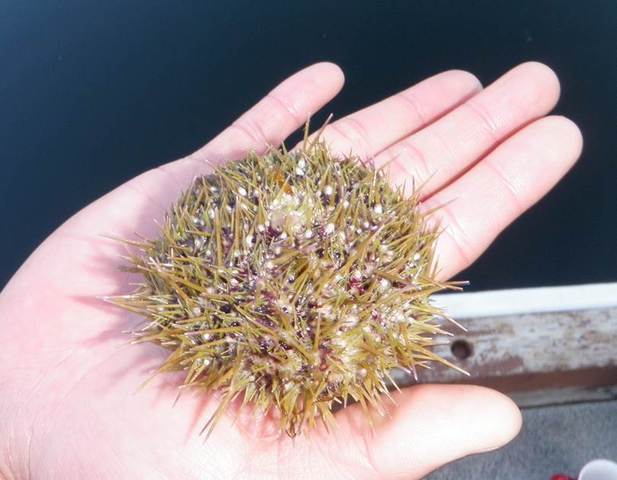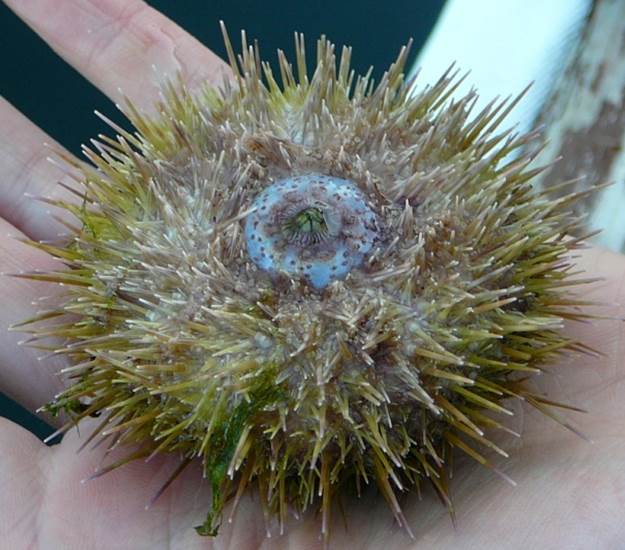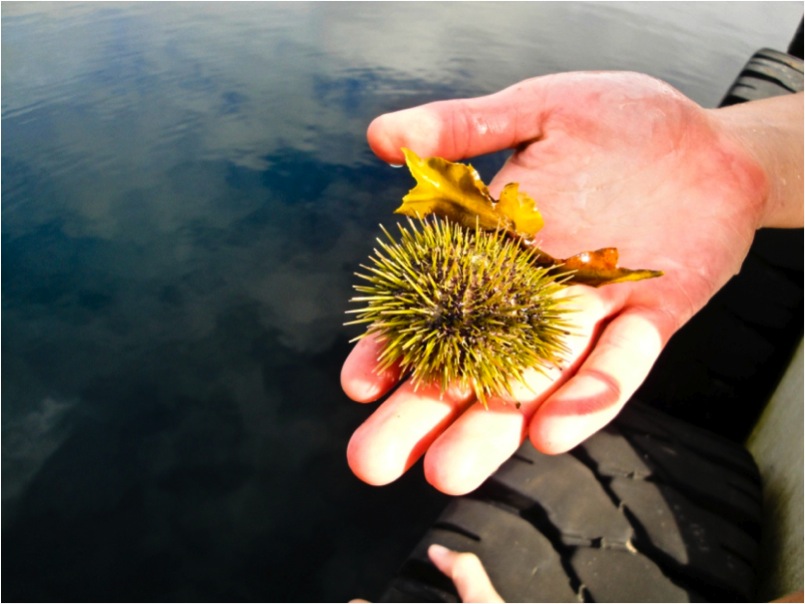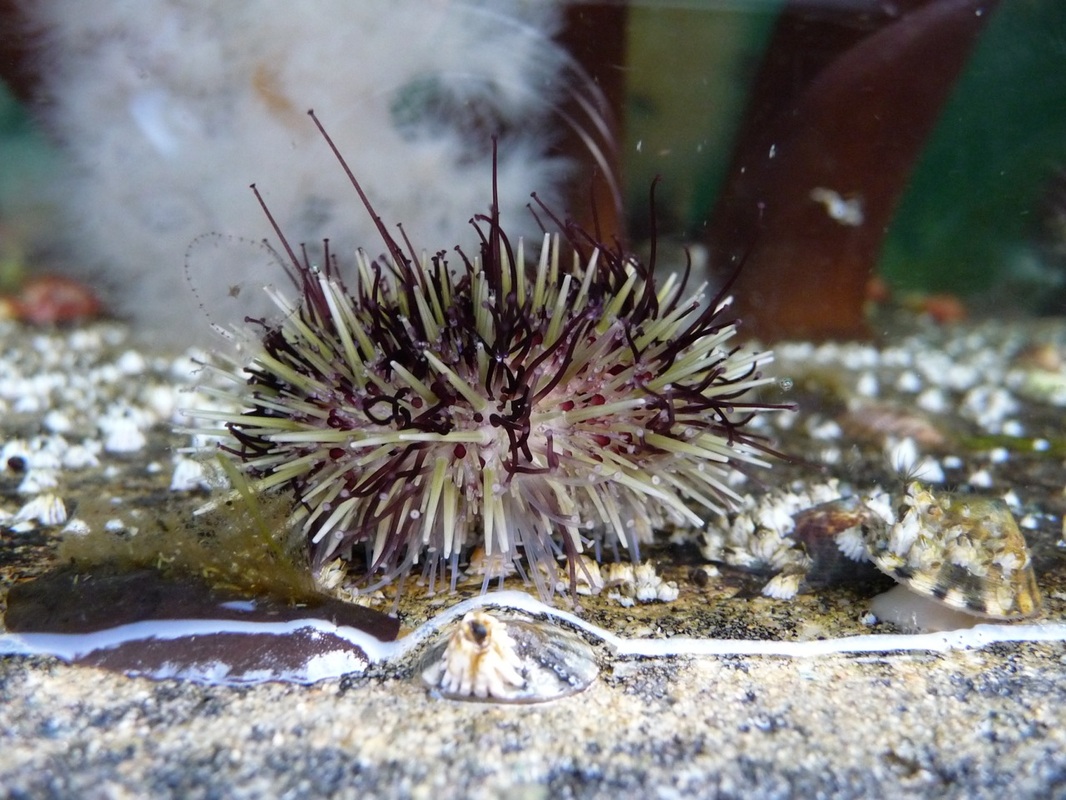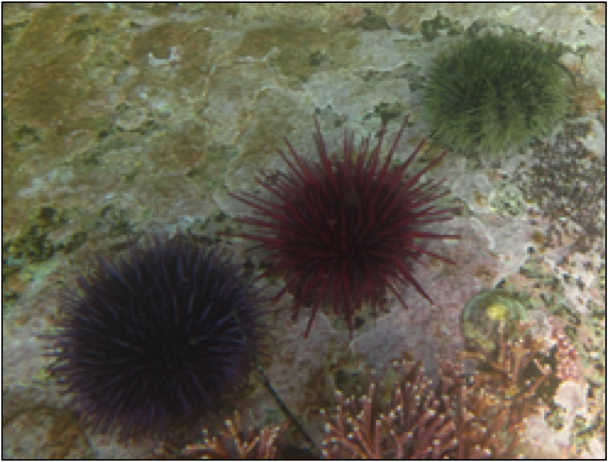Green sea urchin • Strongylocentrotus droebachiensis
{Strongylocentrotus = ball of spines}
Photos by, clockwise from top left: Caylie Boos, Karen Chan (underside of urchin), Rosie Child (with purple and red sea urchins), Chanda Brietzke (juvenile), and Lisa Wielinga.
Identification
While usually green, this species can also have reddish-brown or purplish spines. The spines are relatively short (to 2.5 cm long) and fine, and are all similar in length. The tube feet are purplish, and darker than the spines. This species reaches about 9 cm in diameter. Its diameter is less than twice its thickness.
Habitat & Range
This species prefers habitats protected from direct surge, such as sheltered rocky reefs and kelp beds. It inhabits the intertidal and subtidal to depths of 1140 m. The green sea urchin has a northern, but not circumpolar, distribution around the world. On the Pacific coast of North America its range extends from Alaska to Puget Sound, Washington. It is also found along the Pacific coastline of Russia, and North Atlantic coastlines in Europe.
Similar Species
Juveniles have much paler spines than adult urchins, and may be mistaken for the white sea urchin (Strongylocentrotus pallidus), but this species has a subtidal range and tube feet that are lighter than its spines. Juvenile purple sea urchins (Strongylocentrotus purpuratus) can have pale greenish spines, which could make identification of small pale green urchins tricky.
Human Uses
The roe (actually reproductive organs, not eggs) of sea urchins is a delicacy in Japan, where they are called uni, and they are commercially harvested for this purpose. Maine became a massive exporter of sea urchins on the east coast in the 1990s, but populations were overharvested and have been slow to recover. Click here to read more.
Intriguing Info
Sea urchins, sea otters, and bull kelp (Nereocystis leutkeana) are intimately tied together. When sea otters — which prey on urchins — are absent, sea urchin populations can rise to levels where they can devastate kelp forests. These "deforested" areas of ocean floor are known as 'urchin barrens,' where the productive kelp forest habitat is absent. Sea otters were absent along much of the west coast until very recently, as a result of overhunting in the 18th and 19th centuries. For more on the role of sea urchins and kelp forests, see this article.
While usually green, this species can also have reddish-brown or purplish spines. The spines are relatively short (to 2.5 cm long) and fine, and are all similar in length. The tube feet are purplish, and darker than the spines. This species reaches about 9 cm in diameter. Its diameter is less than twice its thickness.
Habitat & Range
This species prefers habitats protected from direct surge, such as sheltered rocky reefs and kelp beds. It inhabits the intertidal and subtidal to depths of 1140 m. The green sea urchin has a northern, but not circumpolar, distribution around the world. On the Pacific coast of North America its range extends from Alaska to Puget Sound, Washington. It is also found along the Pacific coastline of Russia, and North Atlantic coastlines in Europe.
Similar Species
Juveniles have much paler spines than adult urchins, and may be mistaken for the white sea urchin (Strongylocentrotus pallidus), but this species has a subtidal range and tube feet that are lighter than its spines. Juvenile purple sea urchins (Strongylocentrotus purpuratus) can have pale greenish spines, which could make identification of small pale green urchins tricky.
Human Uses
The roe (actually reproductive organs, not eggs) of sea urchins is a delicacy in Japan, where they are called uni, and they are commercially harvested for this purpose. Maine became a massive exporter of sea urchins on the east coast in the 1990s, but populations were overharvested and have been slow to recover. Click here to read more.
Intriguing Info
Sea urchins, sea otters, and bull kelp (Nereocystis leutkeana) are intimately tied together. When sea otters — which prey on urchins — are absent, sea urchin populations can rise to levels where they can devastate kelp forests. These "deforested" areas of ocean floor are known as 'urchin barrens,' where the productive kelp forest habitat is absent. Sea otters were absent along much of the west coast until very recently, as a result of overhunting in the 18th and 19th centuries. For more on the role of sea urchins and kelp forests, see this article.
References
Harbo, R. M. (1999). Whelks to whales: Coastal marine life of the Pacific Northweest. Madeira Park, BC: Harbour Publishing. P. 146.
Leno, H., Helmstetler, H., and Cowles, D. (2006). Strongylocentrotus droebachiensis. Green Sea Urchin. Invertebrates of the Salish Sea. Rosario Beach Marine Laboratory. Accessed 16/04/2013.
Authors and editors of page
Chanda Brietzke, Kelly Fretwell, and Brian Starzomski (2016).
Harbo, R. M. (1999). Whelks to whales: Coastal marine life of the Pacific Northweest. Madeira Park, BC: Harbour Publishing. P. 146.
Leno, H., Helmstetler, H., and Cowles, D. (2006). Strongylocentrotus droebachiensis. Green Sea Urchin. Invertebrates of the Salish Sea. Rosario Beach Marine Laboratory. Accessed 16/04/2013.
Authors and editors of page
Chanda Brietzke, Kelly Fretwell, and Brian Starzomski (2016).
